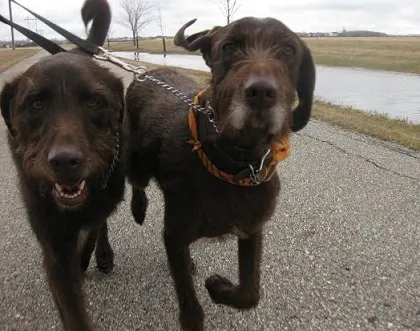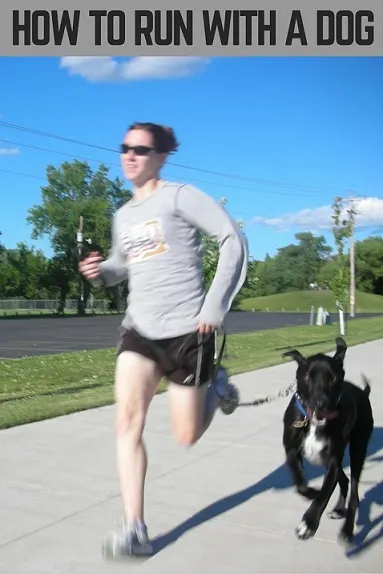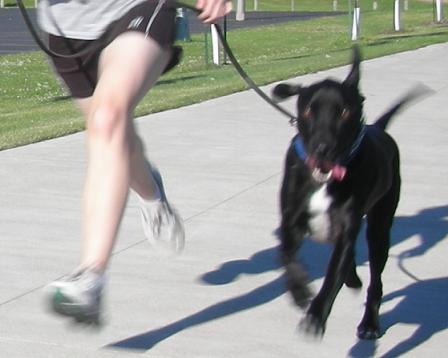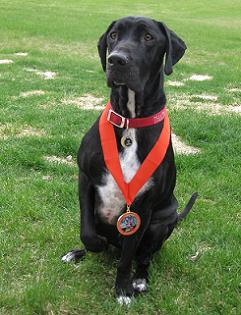Tips for running with dogs
People ask for tips on how to run with a dog since I cover about 40 miles per week offering dog running sessions through my business Run That Mutt.
I also go about 20 miles through dog walking. People are curious about how to run with dogs and how to start a dog jogging business, so I thought I’d answer some of the most common questions here.
How far can I run with my dog?
If you are wondering about how to run with a dog, your first question is probably “how far can my dog run?”
Probably pretty far. Your dog will be fine, although you do need to make sure to start slowly and with a short distance if your dog hasn’t been active lately.
If you’re worried, then start with 1/2 mile. Then increase the distance to 1, 2, 3, 6 miles slowly over a few weeks. Some dogs really can run distances of 5 or even 10+ miles in a day easily. Think dogs meant for hunting or endurance like pointers, huskies, etc.
See my post: Best dogs for running
A good rule of thumb for most dogs is 2.5 to 3 miles regularly and more if that seems easy for your dog (and you).
How can I tell if my dog is too tired during a run?
If she is dragging behind you or panting heavily. If that’s the case, slow down to a walk. Bring water along on hot days.
Can I run with my small dog?
Absolutely!
Small dogs often have more energy and can run longer than the bigger dogs. Most Jack Russell terriers, for example, can easily run 10 miles per day. Start with 1 mile for a few runs, and increase the distance if your dog seems OK. Most smaller breeds should be able to run about 3 miles.
Which dogs shouldn’t go running?
Overweight dogs shouldn’t run because their extra body weight will put too much stress on their joints. Stick to walking until the dog loses some weight. Older dogs with arthritis should also stick to walking, as should any dog with an injury.
Dogs with “short faces” like English bulldogs and Boston terriers can overheat very easily. Running is still great exercise for them, but be very careful on hot days.
Giant-breed dogs like English mastiffs and Newfoundlands are generally lower energy and do not do very well with running. A lot of veterinarians recommend that giant breed dogs stick to walking because it’s easier on their joints. This is good advice.
Always check with your vet if you are not sure if running is safe for your dog.
When is my puppy old enough to go running?
Most veterinarians recommend that large-breed dogs should not go running until they are 1.5 years old because their joints will still be developing up until that point.
I have taken some puppies running when they are around 9 months old as long as I run at a consistent, slow enough pace so the dog is moving at a fast walk and not a full-on gallop.
If you have ever watched a dog “run” with a person, the dog is usually just walking fast while the person is running. This is healthy exercise for the dog and will not put too much stress on his joints.
I do not recommend rollerblading or biking with large-breed puppies or dogs because the faster pace can end up harming their joints. If you’re not sure if running is OK for your puppy, ask her vet or someone who is an expert on the breed.
What if my dog runs too fast for me?
Then make him slow down!
Keep your dog on a leash no longer than 6 feet, and make him run at your speed.
Dogs are sprinters, so they can’t maintain a fast pace for very long. I’m not a “fast” runner by most standards, but I can outpace most of the dogs I run. They lose some steam after about five minutes. We typically run at about a 10-minute mile pace.
How do I keep my dog at my side when we run?
Run with your dog in a formal heel position, meaning she is at your side with her head or shoulder even with your hip. Keep the dog’s collar high on her neck, right under her chin and behind her ears.
When the collar slips to the lower, stronger area of her neck, that gives her more control so stop and adjust it.
Ditch the retractable leash. Use a 6-foot leather leash instead.
In your left hand, hold the leash close to your dog’s collar. In your right hand, hold the slack. Your left hand becomes sort of the “shock absorber” while your right hand is there just in case your left hand drops the leash. Keep the entire leash as loose as possible. I will hold the leash with literally two fingers from each hand to make sure I stay relaxed. A tight leash will only encourage the dog to resist and pull harder.
If the dog pulls, quickly pull up on the leash with your left hand to re-direct her attention back to you. You can also try switching directions.
Keep moving!
What is the best dog collar to stop my dog from pulling?
For most dogs, a simple choke collar or slip lead will work just fine. Martingale collars also work for most dogs. Martingale collars are usually made of nylon and they don’t tighten as much as a standard choke collar.
For powerful, easily excitable dogs, try a prong collar that fits properly. You don’t want the prongs to be too big, and the collar shouldn’t be too tight or too loose. Haltis and Gentle Leaders are also effective once the dog adjusts to wearing one.
Stop using a harness unless it’s specifically designed to prevent pulling.
Will my dog get hurt if I take him running?

For dogs that aren’t used to being walked on pavement, stop and check their paw pads every 15 minutes or so. Dogs that are walked often will develop calloused feet – and that’s a good thing.
If dogs are kept indoors or in the grass all the time, their paws won’t be able to handle a lot of running right away. You’ll have to slowly increase the distance. It would be the equivalent of you going for a run in the street without shoes.
Also watch for any limping or stiffness the day after a run. If the dog is not used to running, she could pull a muscle or feel sore the next day.
How much do I feed my dog if he runs with me?
Measure your dog’s food for each meal and feed him regularly scheduled meals so you know exactly how much your dog eats per day. Do not “free feed” your dog.
If your dog looks a little lean, then feed him more. If he looks a little chubby, then feed him less. If you are increasing your dog’s exercise, then it makes sense that he will require a little more food in order to maintain his healthy weight.
If Ace tags along on a longer run than usual, I might feed him a little extra that day. He is leaner and more active than most dogs, so he eats more than the recommended serving on most commercial dog food bags.
When is it too hot to run with a dog?
Usually it’s too hot to run a dog during the middle of the day in the summer. Black dogs, overweight dogs, short-faced dogs and extra hairy dogs get overheated too easily. White dogs get sunburned too easily.
I don’t recommend muzzles, Gentle Leaders or Haltis for running on hot days. Dogs can still pant while wearing these, but some won’t be able to pant as heavily as they need to.
Bring water along during your summer runs or plan your route so you can loop back home for a quick drink.
Keep a close eye on your dog and take it easy if he starts to pant heavily, slow down or drag behind. Take breaks often and sit in the shade. Signs of heatstroke (hyperthermia) in dogs include rapid panting, dizziness, diarrhea, pale gums and a long, red tongue.
If your dog gets too hot, help him cool down slowly by offering him some water and a chance to rest in a cool, indoor area. Place cool, damp towels under his belly and paws.
Remember, some dogs (like mine) do not have an “off switch” during certain activities such as rollerblading or chasing a ball. It’s up to us to make them take breaks every 15 minutes to avoid overheating.
When I first got Ace I assumed he would stop chasing a ball when he got tired. Boy was I wrong!
When is it too cold to run with a dog?
As long as you keep moving, most dogs can go for a 20-minute run or longer no matter how cold it gets.
I live in North Dakota where the winter temperature is very often 10 below zero or colder. And that’s not counting the windchill.
The dogs are typically just fine for a half-hour run without any kind of dog coat as long as we keep moving. Even the short haired breeds without undercoats (like vizslas) are fine in January.
Dogs have fur coats and they can handle the cold better than us. If you are cold, then head inside. If you are fine, your dog is probably fine.
Obviously you want to take extra precautions on cold days by running closer to home and putting a coat on your dog if he needs one.
And by all means, if your dog is shivering and lifting up her paws for more than a few minutes, bring her inside!
What’s the best kind of dog coat?
Most dogs don’t need a coat.
If your dog seems cold outside, then shop for a dog coat at a sporting goods store that carries hunting gear for dogs.
Don’t buy those cute, fashionable dog coats. Those are cute, but they do nothing for extra warmth. If anything, the coat will get wet and make the dog colder. For serious protection against the cold, get your dog a waterproof vest designed for sporting breeds.
Unfortunately if you have a small dog, you probably won’t be able to find a hunting vest for him. I wouldn’t worry too much. Dogs have their own natural fur coats. They don’t really need more than that.
What kind of dog boots do you recommend in the winter?
I do not recommend dog boots for keeping a dog’s feet warm.
I do recommend dog boots for protection against de-icing chemicals or sharp/jagged ice. Dog boots can also prevent ice and snow from building up between the toes of a longhaired dog.
Anything bulky will feel too awkward for your dog, so look for a lightweight set.
If I don’t run, how can I get my dog tired?
Take him biking or rollerblading with you or purchase a dog backpack for him to wear during walks.
Dog backpacks are awesome for making the dog carry his own, you know, SHIT, when the nearest trash can is a ways away.

More on how to run with a dog – my experience
Saturday I am running in the Fargo Marathon, my first full marathon. I am not quite sure why I decided to sign up for this other than it seemed like a good idea at the time.
Really though, I’ve wanted to run a marathon for about the last five years. I trained for a few 26.2’s starting in 2006, but I always ended up overtraining and injuring myself so I couldn’t participate. This is a very common problem for newer runners.
I’m one of those people who can run through just about any amount of pain, so I would obsessively follow the training schedule, making sure to get in a long run each Saturday.
What I know now is that to an extent, it’s better to undertrain than to overtrain. Get some solid base running in, and don’t worry too much about speed or long runs.
I’m not saying that I undertrained – I run a lot more now than I did in 2006 – but I know when to give my knees a rest. I have been running injury free for at least 18 months. That’s something I know not to take for granted.
A fellow runner told me (at 6 a.m. during a 12-mile outdoor training run in mid-January) that there are only two obstacles that prevent someone from completing a marathon. The first is an injury; the second is never starting.
I think about that a lot, as it applies to pretty much anything in life. If you don’t try, you don’t fail. But you don’t win, either.
Just making it to the starting line on Saturday will be a win for me, something I’ve been chasing since May 2006 when I ran my first 13.1 and became addicted to the thrill of endurance.
I’m planning on running slowly on Saturday, probably sticking with the 5-hour pace group until at least the halfway point. I can’t risk an injury.
Unlike the majority of first-time marathoners, I won’t be able to sit around the office Monday morning icing my knees. I won’t be able to temporarily leave the sport. I want to be out running and walking my dog friends. Plus, it kind of pays my bills 🙂
Thank you to all my canine running buddies
I owe a huge thank you to all my canine training buddies. There is no way I would be a runner if I didn’t have extremely enthusiastic dogs to run with. One dog even tagged along for one of my weekend long runs of 13+ miles. Good boy, Eli!
Most of my longer runs, though, I ran on my own. I’d run the first 14 miles or so alone and then pick up Mr. Ace of Spades for the last two miles.
Running without dogs is totally different than running with dogs.
For me, it’s more relaxing without them.
Running with a dog or two drains my mental energy, something very much needed to complete 26.2 miles. I’m very committed to improving a dog’s leash manners. That means I’m always focused on my surroundings and on where the dog is and what the dog is doing.
A great amount of my physical energy is used to keep the dog at my side and to maintain a quick pace.
I don’t have to worry about any of that on Saturday.
On Saturday I get to relax, breathe, run slowly, enjoy the surroundings and have fun!
I’m making some entertaining signs for my friends to wave around to encourage the runners, and I would love some suggestions. No Google searches allowed! I’ve seen all those signs, and they were only funny the first time.
The best sign idea I’ve come up with so far is:
Hurry! They close the course in five hours!
Leave your creative/inappropriate spectator sign suggestions in the comments. Drinking comments or sexual references encouraged!
What tips do you have for running with a dog?
For more info, see my posts:



Jack OBrien
Thursday 26th of October 2017
I can't run I'm 70 yrs old and the knees are shot. How about a video riding a bike with the dog, I can ride a bike but I'm afraid she will run in front of the bike and get hurt. Thanks.
Lindsay Stordahl
Thursday 26th of October 2017
I wish your knees felt better. Here's a video of my dog Ace and I biking. We used a hands-free leash called the WalkyDog but depending on your dog you may or may not want a hands-free leash. With Ace, it was just as easy to hold his leash but he's not much of a puller. https://www.youtube.com/watch?v=30nd40TExnI
David
Thursday 23rd of June 2016
Are you insane?! 20 miles? Dogs can run further and faster than us? This is the most dangerous article I've ever read about dogs. You have absolutely no sources for your information and I think this post should be deleted. Jack Russell's can "easily run 10 miles a day"? Where is this info coming from? It's just your opinion. Also, the way you act like it's no big deal is arguably worse. This was a disturbing read.
Humans have a MUCH more efficient way of ridding our body of heat. Dogs do not.
Humans can run further distances than 99% of mammals. Please don't say dogs can run further than us.
Smaller dogs can run further than bigger ones? Wrong! They have to expend more energy to go the same distance as a Larger dog. They may have more energy, but that doesn't equate to distance running. Larger dogs can more easily cover ground and can store more fluids for a longer time.
Humans can store more liquid and can more efficiently cool themselves. Dogs store less fluid, have to expend more energy to go the same distance, and have a much much MUCH less efficient way of cooling themselves.
Again, this is an extremely dangerous post. You are so irresponsible for posting it that I don't even know what to say. The fact that it comes up as the top search result when I decided to google this is terrifying.
Your dog SHOULD NOT run more than 1-3 miles a day depending on the breed. Any more is animal abuse. What you are doing is animal abuse and if you came into my clinic saying you run 40 miles a week with your dog, I may report you to authorities.
I'm devastated that this post was the #1 result.
Lindsay Stordahl
Thursday 23rd of June 2016
Of course this is my opinion. I thought that was obvious.
Oliver Sun
Tuesday 13th of October 2015
Hi Lindsay,
Wonderful article. As it so happens, I am starting my own dog jog in business. I have been running w/my Lab for over 3 years now and I'm following my passions (dogs and running) into my own business. I'd love for you to visit my website jogger.dog and see what you think. I'll most likely be reading your book on how to start a DG biz. Hope to hear from you!
Oliver Sun The Dog Jogger
Lindsay Stordahl
Tuesday 20th of October 2015
Hey Oliver. Just checked out your site and it looks really nice!
Ken
Friday 21st of August 2015
I know this is old but I LOVE my dog and ALL SAFETY articles about running with dogs that I read, touch my heart, I don't want anything to ever happen to my little buddy. I just seriously just finished comparing all the collars I bought a few and tested them out, and tried to pick the best one, I am talking about night collars, things that flash, because I feel if I am going to be protected and visible at night, and it's important enough for me to have a flashlight or vest, then it is important to do the same for my little buddy. qualitycampingandhikingoutdoorgear. blogspot . com is where you can find the comparison if you are interested, just goes over all the various types of night collars that you really should use if you're going to take your dog out. They love you so much and honestly cannot make the decision themselves and cannot buy it themselves. They rely on you for your protection.
SABRINA L CANE
Friday 10th of January 2014
:) :P